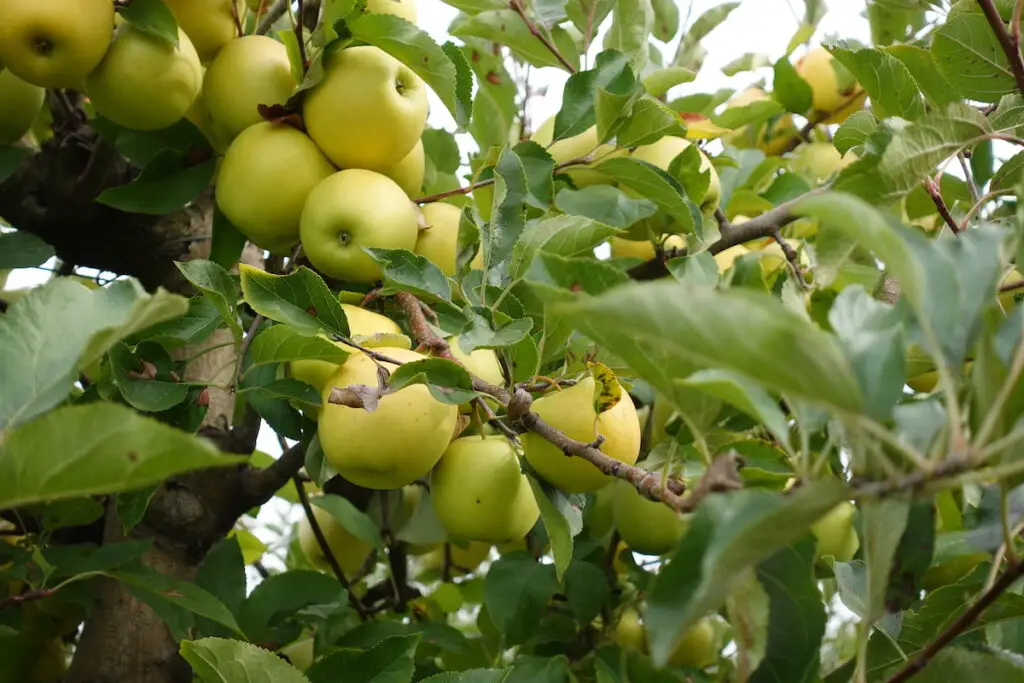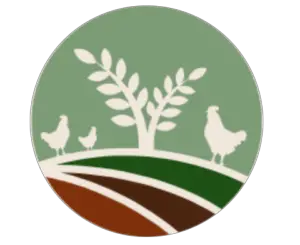The famous saying ‘An Apple a Day Keeps the Doctor Away’ rings true in many American homes. Apples are the 4th most consumed fruit after bananas, strawberries, and grapes. In 2021, the USA produced around 4.9 million tons of apples.
If each member of an average-sized family of four eats an apple every day, that comes to around 120 apples per month. So how many apple trees do I need for a family?
To find out how many apple trees you need, divide your planned yearly consumption in lbs by 250, which is the average yield per tree. A 5 member household that consumes 500 lbs of apples needs to plant two apple trees. Dwarf and semi-dwarf apple trees have 40-80% less yield than standard trees.
The yield of an apple tree depends on its age, variety, and rootstock. Dwarf trees can yield 40 to 100lbs. A semi-dwarf will yield around 250 lbs, and a mature tree up to 500 lbs. If you base your calculations on 3 apples per pound, a mature tree will produce 160 or more apples in a season.
Learn how to raise your own quail and have an unlimited supply of eggs and meat.
| Amount of apples per year | Dwarf tree | Semi-dwarf tree | Standard tree |
| 100 lbs | 3 | 2 | 2 (for pollination) |
| 300 lbs | 9 | 2 | 2 |
| 600 lbs | 18 | 4 | 3 |
| 1000 lbs | 30 | 6 | 4 |
How much apple does the family consume per week/month/year?
Eating an apple a day means that one person will eat seven apples a week. In an average family of 4 people, this means that you are buying around 30 apples per week. In a month, it will be around 120 apples. In a year, it will be well over a thousand apples! This is a lot of apples.
Thinking about this, you may wonder how many apple trees you should plant if you want to provide for all your needs and not spend money at the grocery store. Planting your own trees is a fun and rewarding experience. Depending on the size of your back garden or homestead, you may be able to provide a big portion of the apples your family consumes.
How much apple does a tree yield on average
The yield is dependent on many factors. The most important being the variety, size, and age of the tree.

Variety – There are over 7000 varieties of apple trees grown on the planet. Some yield fruit more abundantly than others. Honeycrisp, Gala and Fuji, along with several others, are among the most abundant apple trees.
Size – Like most fruit trees, apple trees come in dwarf, semi-dwarf, and full sizes. These don’t refer to the various growth stages of apple trees but rather propagated variations of a tree reaching full maturity.
Age – Different apple trees produce varying numbers of fruit at different ages.
With all these factors at play, it can be difficult to predict exactly how many apples a tree will yield. However, a good basis on which to start your planning is to calculate that you will get on average 3 apples per pound, at an average weight of 0.33 pounds per apple.
Standard tree – Yield can be around 500 lbs – 160 apples
Semi-dwarf – Yield can be around 250 lbs – 83 apples
Dwarf – Yield can be around 40 to 100 lbs – 13 to 33 apples
It is interesting to compare these numbers to large-scale commercial farming. In these environments, scientific methods of pollination, fertilization, irrigation, and plant protection are used. The yield of one tree can be anything from 400 to 800, and even over 1000 fruits in a season (source).
Standard apple trees only produce their full crop after 6 – 8 years. In the first few years, you can expect only to get a couple of pounds of ripe apples. Some varieties require up to 10 years to reach full maturity.

Apple varieties that have a higher yield
When selecting apple trees for home or small business use, you want to choose trees that have the highest yield. Here are some of the most popular high-yield trees in the USA.
- Honeycrisp
- Fuji
- Gala
- Red Delicious
- Granny Smith
- Pink Lady
- Golden Delicious
- McIntosh
Keep this in mind when you calculate
If you’re only growing apples for your own consumption, you need to keep in mind that you won’t be able to produce apples for the whole year since in normal household conditions, they can’t be stored for so long.
Most apples can be stored for a few months, but some of them start to go bad after just a few weeks. This is important because you may end up looking after a tree for several years and find out that its apples can only be stored for a few weeks.
Here is an article I wrote about how long various apple types can be stored. It’s well worth reading.
Growing from seed vs buying a pre-cultivated tree
If you decide to grow apple trees from seed, you should start with a higher number than the number of trees you intend to plant and grow. For example, if you want to plant 5 trees, you can germinate 10 or more seeds. If you plant pre-cultivated trees, you only need to buy the number of trees you intend to plant. This gives you a several-year advantage when it comes to harvesting your first fruits.
Growing an apple tree from seed is possible, but it will require a great deal of time and patience.
Apple trees grown from seed are often not ‘true to seed’ and end up with a different flavor. Sometimes, they may even be tastier than the parent tree!
A tree grown from seed can take up to 7 to 8 years to produce a crop. Apple seeds need to be refrigerated for at least 6 weeks in a moist paper towel. During this time, some of them may begin to sprout. You can then transfer the seeds into a pot filled with rich, loamy, well-draining soil. Keep the soil warm and moist. Once they reach a height of 6 inches, they can be planted into your permanent rows. Ensure that they are protected from wind and animals.
Buying pre-cultivated trees will produce apples faster and you know exactly what type of apple flavor you will be getting. But even so, you could wait 2 to 3 years before your tree bears fruit. Pre-cultivated trees are usually much larger when you buy them. Dig a deep hole and line it with organic compost. Remove the tree from its nursery pot and place it into the hole. Fill with rich organic compost and ensure that you water the tree well for the first few weeks.
Pollination factor
Most varieties of apple trees require a pollinating partner to produce fruit. Some varieties are self-fruitful or self-pollinating, but even these varieties do better when they are planted near other pollinating apple trees.
You also must ensure that you choose different apple tree varieties that flower more or less at the same time or have overlapping times. For example, a Pink Lady can be paired with a Fuji, Granny Smith, or Gala apple to produce fruit.
Pollination occurs when the flowers are in bloom and pollen is transferred from the male part of the flower to the female part. Honey bees and other pollinating insects play a large role in transferring pollen between the trees. Wind can also blow pollen from one tree to the next.
Crabapple trees are great pollinators as they are easy to grow and bloom for a long period of time. If you want to grow apple trees like Baldwein, King, Mutsu, Jonagold, or Gravenstein, these are poor pollinators and will require to be paired with a cultivar that is a good pollinator. Good crabapple pollinators are Whitney, Dolgo, Wickson, Manchurian, and Snowdrift.
While most home gardens have enough bees for pollination, setting up a beehive is a great way to encourage natural pollination of your apple trees and get your own delicious honey.
Where to plant the trees in the garden
Another important consideration is the amount of space you have in your garden. You can’t plant a tree anywhere and expect it to produce fruit. They need to be planted strategically, so this is another factor you need to keep in mind when deciding how many apple trees you’re going to plant.
Apple trees thrive best in a warm climate with at least 6 to 8 hours of full sunlight per day. The best spot in your garden is on the north side. Ensure that sunlight won’t be blocked out by tall trees or surrounding structures. You don’t want too much shade falling over the trees.
Your soil should be properly prepared. Ensure that you have light to medium-textured loamy soil that is well-draining. Well-draining soil allows the water to run out and not accumulate at the roots of the tree. Clay-type soil will not allow water to drain and the roots of the tree may rot or become diseased. Apple trees prefer soil that is slightly acidic to neutral. Using a home garden PH monitor, you can check that your soil has a PH value of around 6.5.
If you have high and low areas on your plot, try to plant trees on higher ground. Cold tends to settle into lower areas forming frost pockets and dropping the temperature by many degrees.
Many apple trees require a pollinating partner to produce fruits. Ensure that you plant different varieties within 50 feet of each other. If your neighbor has an apple tree within 50 feet of yours, it may provide the pollination you need. Also, ensure that you plant trees together with others that flower at the same or overlapping times.
Allow space between the trees for the branches to grow. The spacing depends on the type of tree. Plant full-size trees 15 to 18 feet apart. Plant dwarf varieties 6 to 8 feet apart. Planting your trees in rows makes harvesting easier.
What are the factors that influence how much a tree will yield in a given year?
Many factors can influence the yield of your tree. Here are some to consider:
- Bad soil quality will affect the yield.
- Trees that are not self-fruiting need a pollinating partner of a different variety to ensure fruit production.
- Young trees produce far less fruit than mature trees.
- Make sure that the tree can grow in your USDA Climate Zone
- Plant different flowering varieties within 50 feet of one another
- Bugs that attack trees can greatly affect the yield. Common diseases and bugs are Apple Scab, Powdery Mildew, Canker, Aphids, and Apple Sawfly
- Extreme weather conditions will affect the yield
- Trees planted too close together will have smaller yields
- Learn how to prune and thin your trees to produce quality fruit and larger yields
Final Thoughts
Planting apple trees in a home backyard is a rewarding experience for a long-term home farmer. By calculating how many apples your family eats in a month, you can decide on how many trees you need.
If you are planning on selling your apples, you may need the help of a professional to set up a small orchard to give you the yield you require.
References
(1) https://blog-crop-news.extension.umn.edu/2016/07/recovery-and-management-of-corn-and.html
(2) https://www.statista.com/statistics/193274/us-total-apple-production-since-2000/

